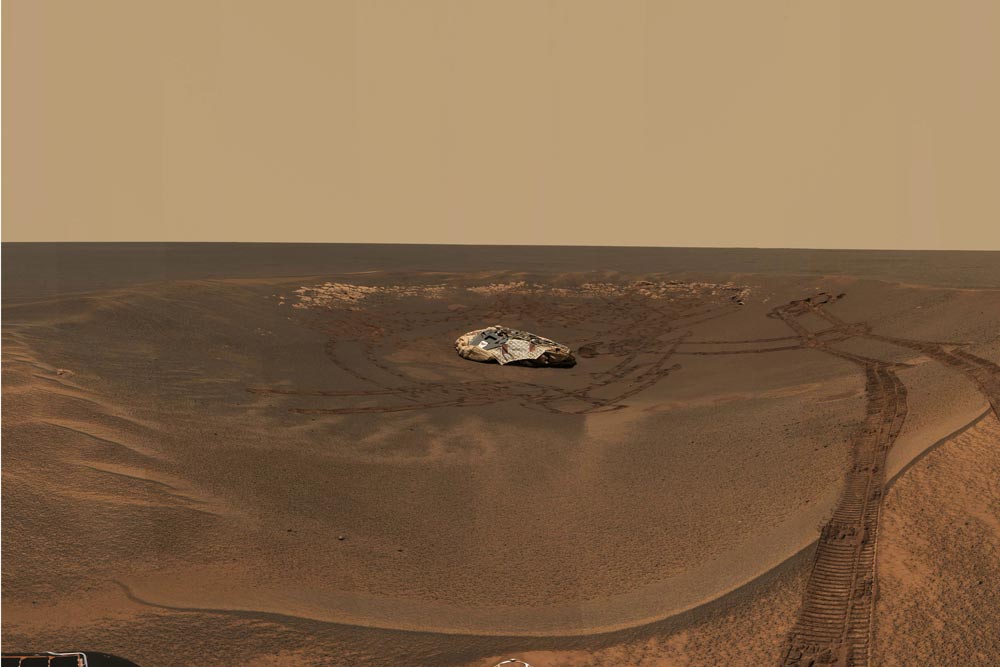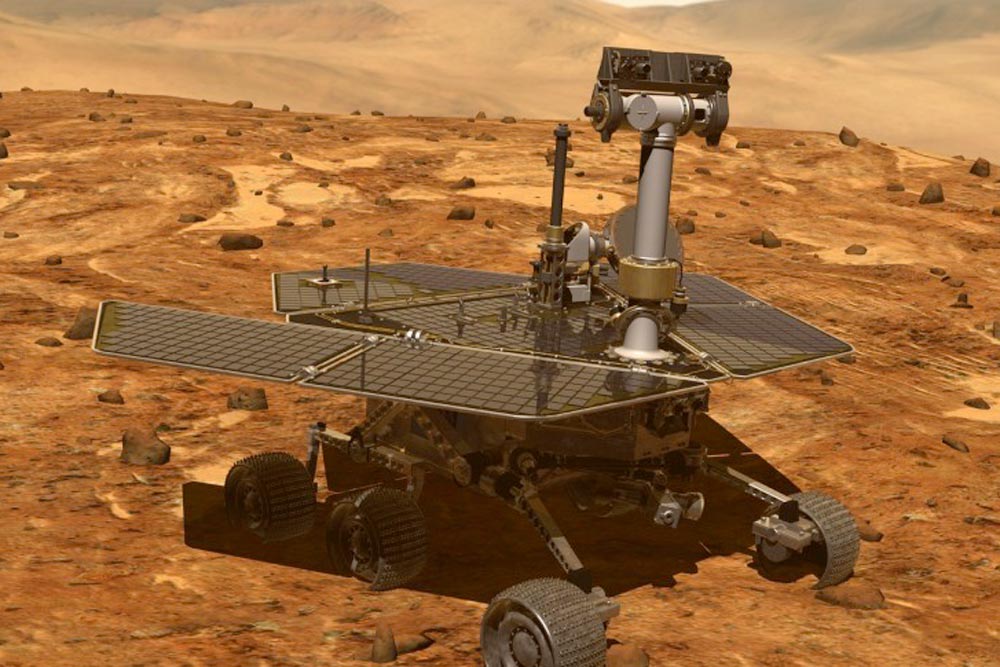NASA's record-breaking Opportunity rover may be gone, but its legacy is assured.
NASA declared Opportunity dead today (Feb. 13), officially closing the books on the golf-cart-size robot's epic 15-year Red Planet run. And run is an apt term, for Opportunity and its twin, Spirit, were the first truly mobile Mars explorers.
Before the solar-powered duo touched down in January 2004, humanity had successfully dropped just four spacecraft on the Martian surface: the Soviet Union's stationary Mars 3 lander in 1971 (which ceased functioning just seconds after touchdown), NASA's similarly sessile Viking 1 and Viking 2 landers in 1976, and the U.S. space agency's Pathfinder mission in 1997. [Occupy Mars: History of Robotic Red Planet Missions (Infographic)]
Pathfinder included a little rover called Sojourner, but that microwave-oven-size robot traveled a total of just 330 feet (100 meters) during its pioneering operational life. Spirit and Opportunity, on the other hand, chewed up miles and miles of red dirt.
"These rovers have transformed the way humanity looks at Mars," said Steve Squyres of Cornell University, the scientific principal investigator of Spirit and Opportunity's Mars Exploration Rover (MER) mission.

"With a mobile vehicle — a vehicle able to climb mountains and descend into craters and see these gorgeous, spectacular vistas — it really changes Mars into a place that seems like a real destination," Squyres told Space.com.
Spirit and Opportunity landed a few weeks apart, in different Red Planet locales. But they shared a main mission goal: to hunt for signs of long-ago liquid-water activity, thereby helping scientists better understand Mars' evolution and past potential to host life.
Get the Space.com Newsletter
Breaking space news, the latest updates on rocket launches, skywatching events and more!

The rovers used a variety of instruments in this quest, including three different spectrometers, a panoramic camera and the high-resolution Microscopic Imager, which delivered magnifying-glass-like views of Red Planet rock and dirt.
And the craft had six wheels each and were expected to make tracks: The driving-distance goal for each rover was 2,000 feet (600 meters) over the course of the scheduled three-month mission.
"They were intended from the outset to be robotic field geologists," Squyres said.
Mobility is crucial in this line of work, he added: "Imagine you're a field geologist, and someone takes you out in a helicopter and sets you down in a fascinating new place — and then they nail your boots to the ground. You can't move. That's not the way geology works." [10 Amazing Mars Discoveries by Rovers Spirit & Opportunity]
Spirit and Opportunity moved, of course, over surprising spans of time and space. Spirit put 4.8 miles (7.7 kilometers) on its odometer before falling silent in the spring of 2010 — six years after its warranty expired. And Opportunity covered more than a marathon's worth of distance, racking up 28.06 miles (45.16 km) on Mars. No other vehicle, robotic or crewed, has ever traveled farther on the surface of another world.
Opportunity kept rolling along until last June, when a mammoth dust storm boiled up around the rover's digs on the rim of the 14-mile-wide (22 km) Endeavour Crater. All the dust in the air prevented sunlight from reaching Opportunity's solar panels, and the robot was unable to recharge its batteries. Opportunity's last communication with its handlers occurred on June 10.
The storm eventually enshrouded all of Mars. By September, however, the tempest had mostly cleared, and there was still no word from Opportunity. The mission team kept trying to wake the rover up for months thereafter, hoping that a few strong gusts of wind would blast the dust off Opportunity's solar panels and allow the robot to recharge and wake up.
But it wasn't meant to be, and NASA officially pulled the plug today.
Squyres, you may be surprised to hear, isn't sad about the news. "I feel great about this," he said, stressing that both Spirit and Opportunity died honorable deaths after doing far more than was expected of them.
Both rovers found plenty of evidence that Mars was relatively warm and wet long ago, with environments that could well have supported life as we know it. Spirit, for example, rolled through an ancient hydrothermal system, revealing that at least some parts of Mars also featured energy sources that ancient organisms could have exploited.
And the duo's work has paved the way for even more-ambitious Red Planet roving. The car-size Curiosity rover has been characterizing possibly habitable environments inside Mars' 96-mile-wide (154 km) Gale Crater since August 2012, and NASA plans to launch the life-hunting Mars 2020 rover next year. (Mars 2020 will look for signs of past, not extant, life.)
So there are many aspects to the MER legacy — for example, making Mars a semifamiliar place, revealing secrets about the planet's possibly life-supporting past, and developing the engineering know-how to keep robots alive and productive on a frigid, radiation-blasted planet for years and years. And the mission has probably provided some life-changing inspiration to a fair few young folks along the way as well.
"My fondest hope for that aspect of our mission is that there were some kids — 6, 7, 8 years old — watching" the Spirit and Opportunity landing events back in 2004, Squyres said. "And they see us on TV jumping up and down like we just won the Super Bowl. We have a rover on Mars! And they think, 'Wow! That's really cool! But I bet I can do better.'"
Mike Wall's book about the search for alien life, "Out There" (Grand Central Publishing, 2018; illustrated by Karl Tate) is out now. Follow him on Twitter @michaeldwall. Follow us on Twitter @Spacedotcom or Facebook.
Join our Space Forums to keep talking space on the latest missions, night sky and more! And if you have a news tip, correction or comment, let us know at: community@space.com.

Michael Wall is a Senior Space Writer with Space.com and joined the team in 2010. He primarily covers exoplanets, spaceflight and military space, but has been known to dabble in the space art beat. His book about the search for alien life, "Out There," was published on Nov. 13, 2018. Before becoming a science writer, Michael worked as a herpetologist and wildlife biologist. He has a Ph.D. in evolutionary biology from the University of Sydney, Australia, a bachelor's degree from the University of Arizona, and a graduate certificate in science writing from the University of California, Santa Cruz. To find out what his latest project is, you can follow Michael on Twitter.









